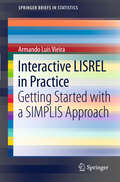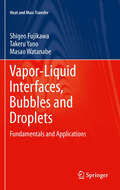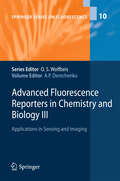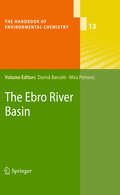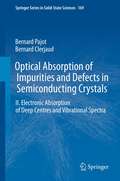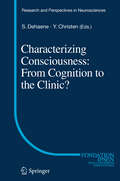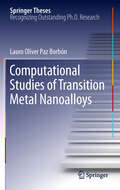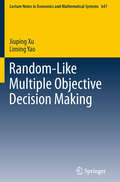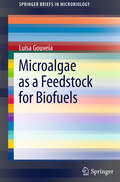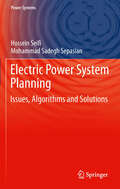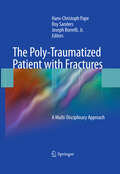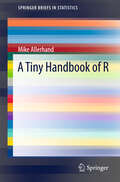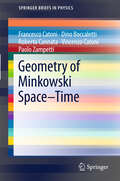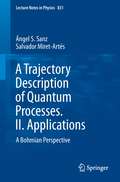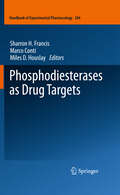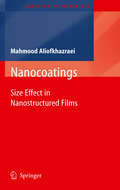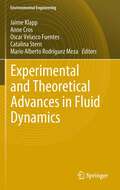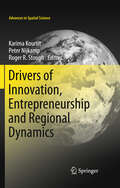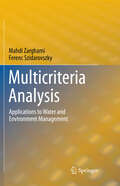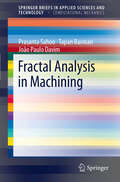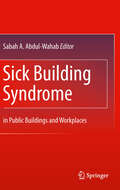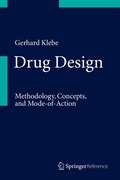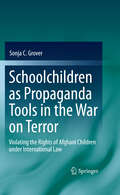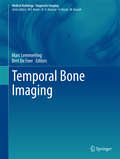- Table View
- List View
Interactive LISREL in Practice: Getting Started with a SIMPLIS Approach
by Armando Luis Vieira"Getting Started with a SIMPLIS Approach" is particularly appropriate for those users who are not experts in statistics, but have a basic understanding of multivariate analysis that would allow them to use this handbook as a good first foray into LISREL. Part I introduces the topic, presents the study that serves as the background for the explanation of matters, and provides the basis for Parts II and III, which, in turn, explain the process of estimation of the measurement model and the structural model, respectively. In each section, we also suggest essential literature to support the utilization of the handbook. After having read the book, readers will have acquired a basic knowledge of structural equation modeling, namely using the LISREL program, and will be prepared to continue with the learning process.
Vapor-Liquid Interfaces, Bubbles and Droplets
by Masao Watanabe Takeru Yano Shigeo FujikawaPhysically correct boundary conditions on vapor-liquid interfaces are essential in order to make an analysis of flows of a liquid including bubbles or of a gas including droplets. Suitable boundary conditions do not exist at the present time. This book is concerned with the kinetic boundary condition for both the plane and curved vapor-liquid interfaces, and the fluid dynamics boundary condition for Navier-Stokes(fluid dynamics) equations. The kinetic boundary condition is formulated on the basis of molecular dynamics simulations and the fluid dynamics boundary condition is derived by a perturbation analysis of Gaussian-BGK Boltzmann equation applicable to polyatomic gases. The fluid dynamics boundary condition is applied to actual flow problems of bubbles in a liquid and droplets in a gas.
Advanced Fluorescence Reporters in Chemistry and Biology III: Applications in Sensing and Imaging (Springer Series on Fluorescence #10)
by Alexander P. DemchenkoThe key element of any fluorescence sensing or imaging technology is the fluorescence reporter, which transforms the information on molecular interactions and dynamics into measurable signals of fluorescence emission. This book, written by a team of frontline researchers, demonstrates the broad field of applications of fluorescence reporters, starting from nanoscopic properties of materials, such as self-assembled thin films, polymers and ionic liquids, through biological macromolecules and further to living cell, tissue and body imaging. Basic information on obtaining and interpreting experimental data is presented and recent progress in these practically important areas is highlighted. The book is addressed to a broad interdisciplinary audience.
The Ebro River Basin
by Damià Barceló Mira PetrovicThe Ebro is a typical Mediterranean river characterized by seasonal low flows and extreme flush effects, with important agricultural and industrial activity that has caused heavy contamination problems. This volume deals with soil-sediment-groundwater related issues in the Ebro river basin and summarizes the results generated within the European Union-funded project AquaTerra. The following topics are highlighted: Hydrology and sediment transport and their alterations due to climate change, aquatic and riparian biodiversity in the Ebro watershed, occurrence and distribution of a wide range of priority and emerging contaminants, effects of chemical pollution on biota and integration of climate change scenarios with several aspects of the Ebro's hydrology and potential impacts of climate change on pollution. The primary objective of the book is to lay the foundation for a better understanding of the behavior of environmental pollutants and their fluxes with respect to climate and land use changes.
Optical Absorption of Impurities and Defects in Semiconducting Crystals
by Bernard Pajot Bernard ClerjaudThis book outlines, with the help of several specific examples, the important role played by absorption spectroscopy in the investigation of deep-level centers introduced in semiconductors and insulators like diamond, silicon, germanium and gallium arsenide by high-energy irradiation, residual impurities, and defects produced during crystal growth. It also describes the crucial role played by vibrational spectroscopy to determine the atomic structure and symmetry of complexes associated with light impurities like hydrogen, carbon, nitrogen and oxygen, and as a tool for quantitative analysis of these elements in the materials.
Characterizing Consciousness: From Cognition To The Clinic? (Research and Perspectives in Neurosciences)
by Stanislas Dehaene Yves ChristenFifteen of the foremost scientists in this field presented testable theoretical models of consciousness and discussed how our understanding of the role that consciousness plays in our cognitive processes is being refined with some surprising results.
Computational Studies of Transition Metal Nanoalloys (Springer Theses)
by Lauro Oliver BorbónThe focus of this thesis is the computational modelling of transition metal bimetallic (nanoalloy) clusters. More specifically, the study of Pd-Pt, Ag-Pt, Au-Au and Pd-Au as a few tens of atoms in the gas phase. The author used a combination of global optimization techniques - coupled with a Gupta-type empirical many-body potential - and Density Functional Theory (DFT) calculations to study the structures, bonding and chemical ordering, as well as investigate the chemisorptions of hydrogen and carbon monoxide on bimetallic clusters. This research is highly relevant to experimental catalytic studies and has resulted in more than seven publications in international journals.
Random-Like Multiple Objective Decision Making
by Jiuping Xu Liming YaoWhat are the random-like phenomena that can be found everywhere in real-life world? When carrying out a random sampling survey on the traffic situation, we often obtain some descriptive results such as approximately expedite, a little crowded and so on, therefore, the average level should be regarded as the random fuzzy phenomenon, which is one of the random-like phenomena. Decision makers usually need to make the decision for these problems with random-like phenomena. Which model should be constructed for them? How should we handle these models to find the optimal strategy? How can we apply these models to solve real-life problems with random-like phenomena? In order to answer these questions, this book provides an up-to-date methodology system 5MRP for random-like multiple objective decision making, which includes problem system with random-like phenomena, model system with random-like coefficients, research system with random-like uncertain methods. Some practical applications are also provided to illustrate the effectiveness of the proposed methodology system. Researchers, practitioners and students in systems science, economics, mathematics, information, engineering and MS/OR will get a lot of useful references from this research monograph.
Microalgae as a Feedstock for Biofuels
by Luisa GouveiaThis Brief provides a concise review of the potential use of microalgae for biofuel production. The following topics are highlighted: the advantages of microalgae over conventional biofuel-producing crops; technological processes for energy production using microalgae; microalgal biomass production systems, production rates and costs; algae cultivation strategies and main culture parameters; biomass harvesting technologies and cell disruption; CO2 sequestration; life cycle analysis; and algal biorefinery strategies. The conclusions section discusses the contribution of the technologies described to environmental sustainability and future prospects.
Electric Power System Planning
by Hossein Seifi Mohammad Sadegh SepasianThe present book addresses various power system planning issues for professionals as well as senior level and postgraduate students. Its emphasis is on long-term issues, although much of the ideas may be used for short and mid-term cases, with some modifications. Back-up materials are provided in twelve appendices of the book. The readers can use the numerous examples presented within the chapters and problems at the end of the chapters, to make sure that the materials are adequately followed up. Based on what Matlab provides as a powerful package for students and professional, some of the examples and the problems are solved in using M-files especially developed and attached for this purpose. This adds a unique feature to the book for in-depth understanding of the materials, sometimes, difficult to apprehend mathematically. Chapter 1 provides an introduction to Power System Planning (PSP) issues and basic principles. As most of PSP problems are modeled as optimization problems, optimization techniques are covered in some details in Chapter 2. Moreover, PSP decision makings are based on both technical and economic considerations, so economic principles are briefly reviewed in Chapter 3. As a basic requirement of PSP studies, the load has to be known. Therefore, load forecasting is presented in Chapter 4. Single bus Generation Expansion Planning (GEP) problem is described in Chapter 5. This study is performed using WASP-IV, developed by International Atomic Energy Agency. The study ignores the grid structure. A Multi-bus GEP problem is discussed in Chapter 6 in which the transmission effects are, somehow, accounted for. The results of single bus GEP is used as an input to this problem. SEP problem is fully presented in Chapter 7. Chapter 8 devotes to Network Expansion Planning (NEP) problem, in which the network is planned. The results of NEP, somehow, fixes the network structure. Some practical considerations and improvements such as multi-voltage cases are discussed in Chapter 9. As NEP study is typically based on some simplifying assumptions and Direct Current Load Flow (DCLF) analysis, detailed Reactive Power Planning (RPP) study is finally presented in Chapter 10, to guarantee acceptable ACLF performance during normal as well as contingency conditions. This, somehow, concludes the basic PSP problem. The changing environments due to power system restructuring dictate some uncertainties on PSP issues. It is shown in Chapter 11 that how these uncertainties can be accounted for. Although is intended to be a text book, PSP is a research oriented topic, too. That is why Chapter 12 is devoted to research trends in PSP. The chapters conclude with a comprehensive example in Chapter 13, showing the step-by-step solution of a practical case.
The Poly-Traumatized Patient with Fractures
by Hans-Christoph Pape Roy Sanders Joseph Borrelli Jr.This guide provides practical information for the care of patients with blunt injuries. It covers the care for truncal injuries (head, chest, abdomen) and fracture care of the extremities, the pelvis and the spine in a condensed fashion. Unlike previous, anatomically oriented outlines, this combines the anatomic location with frequent injury combinations. It is written for orthopedic and trauma surgeons, offering them a condensed outline of fracture treatment. In addition, all aspects of trauma care are covered, including associated injuries that may alter the decision making in patients with polytrauma.
Non-Timber Forest Products in the Global Context
by Charlie Shackleton Patricia Shanley Sheona ShackletonThis book provides a comprehensive, global synthesis of current knowledge on the potential and challenges associated with the multiple roles, use, management and marketing of non-timber forest products (NTFPs). There has been considerable research and policy effort surrounding NTFPs over the last two and half decades. The book explores the evolution of sentiments regarding the potential of NTFPs in promoting options for sustainable multi-purpose forest management, income generation and poverty alleviation. Based on a critical analysis of the debates and discourses it employs a systematic approach to present a balanced and realistic perspective on the benefits and challenges associated with NTFP use and management within local livelihoods and landscapes, supported with case examples from both the southern and northern hemispheres. This book covers the social, economic and ecological dimensions of NTFPs and closes with an examination of future prospects and research directions.
A Tiny Handbook of R (SpringerBriefs in Statistics)
by Mike AllerhandThis Brief provides a roadmap for the R language and programming environment with signposts to further resources and documentation.
Geometry of Minkowski Space-Time
by Dino Boccaletti Paolo Zampetti Vincenzo Catoni Roberto Cannata Francesco CatoniThis book provides an original introduction to the geometry of Minkowski space-time. A hundred years after the space-time formulation of special relativity by Hermann Minkowski, it is shown that the kinematical consequences of special relativity are merely a manifestation of space-time geometry. The book is written with the intention of providing students (and teachers) of the first years of University courses with a tool which is easy to be applied and allows the solution of any problem of relativistic kinematics at the same time. The book treats in a rigorous way, but using a non-sophisticated mathematics, the Kinematics of Special Relativity. As an example, the famous "Twin Paradox" is completely solved for all kinds of motions. The novelty of the presentation in this book consists in the extensive use of hyperbolic numbers, the simplest extension of complex numbers, for a complete formalization of the kinematics in the Minkowski space-time. Moreover, from this formalization the understanding of gravity comes as a manifestation of curvature of space-time, suggesting new research fields.
A Trajectory Description of Quantum Processes. II. Applications: A Bohmian Perspective (Lecture Notes in Physics #831)
by Ángel S. Sanz Salvador Miret-ArtésTrajectory-based formalisms are an intuitively appealing way of describing quantum processes because they allow the use of "classical" concepts. Beginning as an introductory level suitable for students, this two-volume monograph presents (1) the fundamentals and (2) the applications of the trajectory description of basic quantum processes. This second volume is focussed on simple and basic applications of quantum processes such as interference and diffraction of wave packets, tunneling, diffusion and bound-state and scattering problems. The corresponding analysis is carried out within the Bohmian framework. By stressing its interpretational aspects, the book leads the reader to an alternative and complementary way to better understand the underlying quantum dynamics.
Phosphodiesterases as Drug Targets
by Marco Conti Miles D. Houslay Sharron H. FrancisCyclic nucleotide phosphodiesterases (PDEs) are promising targets for pharmacological intervention. Multiple PDE genes, isoform diversity, selective expression and compartmentation of the isoforms, and an array of conformations of PDE proteins are properties that challenge development of drugs that selectively target this class of enzymes. Novel characteristics of PDEs are viewed as unique opportunities to increase specificity and selectivity when designing novel compounds for certain therapeutic indications. This chapter provides a summary of the major concepts related to the design and use of PDE inhibitors.
Nanocoatings
by Mahmood AliofkhazraeiSize effect in structures has been taken into consideration over the last years. In comparison with coatings with micrometer-ranged thickness, nanostructured coatings usually enjoy better and appropriate properties, such as strength and resistance. These coatings enjoy unique magnetic properties and are used with the aim of producing surfaces resistant against erosion, lubricant system, cutting tools, manufacturing hardened sporadic alloys, being resistant against oxidation and corrosion. This book reviews researches on fabrication and classification of nanostructured coatings with focus on size effect in nanometric scale. Size effect on electrochemical, mechanical and physical properties of nanocoatings are presented.
Experimental and Theoretical Advances in Fluid Dynamics
by Jaime Klapp Anne Cros Catalina Stern Mario Alberto Rodriguez Meza Oscar Velasco FuentesThe book is comprised of lectures and selected contributions presented at the Enzo Levi and XVI Annual Meeting of the Fluid Dynamic Division of the Mexican Physical Society in 2010. It is aimed at fourth year undergraduate and graduate students, as well as scientists in the fields of physics, engineering and chemistry with an interest in fluid dynamics from the experimental and theoretical point of view. The lectures are introductory and avoid the use of complicated mathematics. The other selected contributions are also geared to fourth year undergraduate and graduate students. The fluid dynamics applications include multiphase flow, convection, diffusion, heat transfer, rheology, granular material, viscous flow, porous media flow, geophysics and astrophysics. The material contained in the book includes recent advances in experimental and theoretical fluid dynamics and will be of great use to those involved in either teaching and/or research.
Drivers of Innovation, Entrepreneurship and Regional Dynamics
by Roger R. Stough Peter Nijkamp Karima KourtitThe need for informed and effective insights into key concepts and models of regional development and growth, from an endogenous growth perspective, has risen over the past decade. These recent advances address in particular local and regional assets and characteristics comprising inter alia creativity, knowledge, innovation forces and entrepreneurship. Access to and exploitation of these modern forms of human and social capital are of paramount importance for the dynamic regional economic environment in a city or region. This volume offers an overview and critical treatment of the spatial-economic roots, opportunities and impacts of new growth strategies, mainly from an evidence-based perspective. In the various contributions to this volume, relevant findings and strategic options are interpreted and discussed from both an analytical and a policy perspective to help cultivate creativity, human capital development and innovation as well as entrepreneurial activity, with a view to exploit the drivers of economic development, in order to strengthen the competitive edge of cities and regions.
Multicriteria Analysis: Applications to Water and Environment Management
by Ferenc Szidarovszky Mahdi ZarghamiMulticriteria analysis is one of the most important fields of decision science. This book gives an outline of the formulation of an appropriate model and presents a comprehensive summary of the most popular methods for solving multicriteria decision problems. In addition to the classical approach the book introduces fuzzy and stochastic methodology, models with uncertainty, social choice and conflict resolution. All methods are illustrated with easy to follow simple examples. At the end of each chapter detailed case studies are given in water and environment management including inter-basin water transfer, urban water management, water allocation, groundwater quality management, forest treatment, ranking water resources projects, reservoir planning, water distribution network design and long-term watershed management. The new methodology and the wide variety of case studies are not easily accessible elsewhere.
Fractal Analysis in Machining
by J. Paulo Davim Tapan Barman Prasanta SahooThe concept of fractals is often considered to describe surface roughness. Fractals retain all the structural information and are characterized by a single descriptor, the fractal dimension, D. Fractal dimension is an intrinsic property of the surface and independent of the filter processing of measuring instrument as well as the sampling length scale. This book cover fractal analysis of surface roughness in different machining processes such as Computer Numeric Control (CNC) end milling, CNC turning, electrical discharge machining and cylindrical grinding. The content here presented adds a significant contribution to the existing literature, with interest to both industrial and academic public.
Sick Building Syndrome
by Sabah A. Abdul-WahabThis volume throws light on the Sick Building Syndrome in Libraries and other public buildings, and the extent to which it is influenced by the internal environment of libraries. One of the signs of this disease is that the person suffers from a set of symptoms closely related to his/her presence in the building, without the identification of any clear causes, and his/her relief of these symptoms when he/she are out of the building. Hence, the book sheds on the extent to which the interior environment impacts upon the health of the people, and the extent to which this is reflected in their performance. The book can be used for teaching, research, and professional reference. It concludes with the recommendation that is essential to observe environmental dimensions when designing library and public buildings, taking into consideration the expected impact of SBS in library and public buildings on people. The significance of the book derives from the fact that it is the first of its kind to examine the issue of the interior environment and SBS of library and public building worldwide.
Drug Design: Methodology, Concepts, and Mode-of-Action
by Gerhard KlebeUnique work on structure-based drug design, covering multiple aspects of drug discovery and development. Fully colored, many images, computer animations of 3D structures (these only in electronic form). Makes the spatial aspects of interacting molecules clear to the reader, covers multiple applications and methods in drug design. Structures by mode of action, no therapeutic areas. Of high relevance for academia and industrial research. Focus on gene technology in drug design, omics-technologies computational methods experimental techniques of structure determination multiple examples on mode of action of current drugs, ADME-tox properties in drug development, QSAR methods, combinatorial chemistry, biologicals, ribosome, targeting protein-protein interfaces.
Schoolchildren as Propaganda Tools in the War on Terror
by Sonja C. GroverThis book explores in what ways both sides involved in the so-called war on terror are using schoolchildren as propaganda tools while putting the children's security at grave risk. The book explores how terrorists use attacks on education to attempt to destabilize the government while the government and the international aid community use increases in school attendance as an ostensible index of largely illusory progress in the overall security situation and in development. The book challenges the notion that unoccupied civilian schools are not entitled under the law of armed conflict to a high standard of protection which prohibits their use for military purposes. Also examined are the potential violations of international law that can occur when government and education aid workers encourage and facilitate school attendance, as they do, in areas within conflict-affected states such as Afghanistan where security for education is inadequate and the risk of terror attacks on education high.
Temporal Bone Imaging
by Marc Lemmerling Bert FoerThis book provides a complete overview of imaging of normal and diseased temporal bone. After description of indications for imaging and the cross-sectional imaging anatomy of the area, subsequent chapters address the various diseases and conditions that affect the temporal bone and are likely to be encountered regularly in clinical practice. The classic imaging methods are described and discussed in detail, and individual chapters are included on newer techniques such as functional imaging and diffusion-weighted imaging. There is also a strong focus on postoperative imaging. Throughout, imaging findings are documented with the aid of numerous informative, high-quality illustrations. Temporal Bone Imaging, with its straightforward structure based essentially on topography, will prove of immense value in daily practice.
